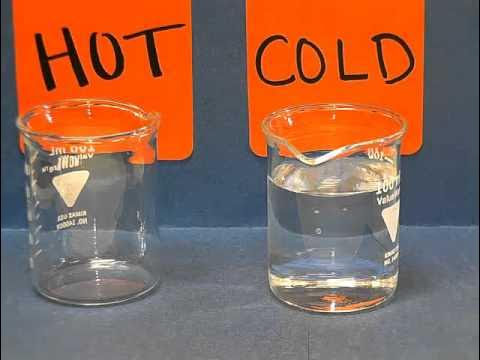PRAKTIKUM LAJU REAKSI Tentang "Pengaruh Suhu Terhadap Laju Reaksi"
Summary
TLDRIn this experiment, Tenda Victoria Karepowan from Universitas Negeri Manado demonstrates how temperature affects the rate of sugar dissolution in water. By preparing three glasses of water at different temperatures (hot, room temperature, and cold), she adds a spoonful of sugar to each and times the dissolution process using a stopwatch. The results show that sugar dissolves fastest in hot water (54 seconds), slower in room temperature water (1 minute), and slowest in cold water (2 minutes and 44 seconds), illustrating how temperature influences reaction rates.
Takeaways
- 😀 The experiment demonstrates how temperature affects the rate of reaction, specifically the dissolution of sugar in water.
- 😀 The experiment uses three different temperatures of water: hot, room temperature, and cold.
- 😀 1 tablespoon of sugar is added to each glass of water for the experiment.
- 😀 A stopwatch is used to measure the time it takes for the sugar to dissolve in each water sample.
- 😀 The dissolution process is faster in hot water than in room temperature or cold water.
- 😀 Hot water dissolves the sugar in **54 seconds**.
- 😀 Room temperature water dissolves the sugar in **1 minute**.
- 😀 Cold water takes the longest, dissolving the sugar in **2 minutes and 44 seconds**.
- 😀 The results indicate that temperature has a direct impact on the rate of reaction, with higher temperatures speeding up the process.
- 😀 The experiment was conducted by Tenda Victoria Karepowan from Universitas Negeri Manado.
- 😀 The video concludes with a message about the usefulness of the experiment and its educational value.
Q & A
What is the main focus of the practical experiment in the video?
-The main focus of the practical experiment is to observe the effect of temperature on the rate at which sugar dissolves in water.
What materials are required for the experiment described in the video?
-The materials required include three glasses of water at different temperatures (hot, room temperature, and cold) and sugar.
How is the experiment set up?
-The experiment is set up by preparing three glasses of water with different temperatures, and then adding one tablespoon of sugar to each glass.
What tool is used to measure the time it takes for the sugar to dissolve?
-A stopwatch is used to measure the time it takes for the sugar to dissolve in each glass of water.
What are the three different water temperatures used in the experiment?
-The three different water temperatures used in the experiment are hot water, room temperature water, and cold water.
What happens after adding sugar to the water in the experiment?
-After adding sugar to the water, the experimenter observes the dissolution rate of the sugar, using a stopwatch to measure the time it takes to dissolve completely.
How does the temperature of the water affect the dissolution rate of sugar?
-The dissolution rate of sugar is faster in hot water, slower in room temperature water, and slowest in cold water, as shown by the different times recorded for each temperature.
What are the recorded times for sugar to dissolve in the three different water temperatures?
-The recorded times are 54 seconds for hot water, 1 minute for room temperature water, and 2 minutes and 44 seconds for cold water.
Why is stirring the solution with a spoon mentioned in the script?
-Stirring the solution with a spoon helps speed up the dissolution process, but the experiment still measures the time it takes for the sugar to dissolve in each solution.
What is the purpose of this experiment in understanding chemical reactions?
-The purpose of the experiment is to demonstrate how temperature can influence the rate of a chemical reaction, in this case, the dissolution of sugar in water.
Outlines

This section is available to paid users only. Please upgrade to access this part.
Upgrade NowMindmap

This section is available to paid users only. Please upgrade to access this part.
Upgrade NowKeywords

This section is available to paid users only. Please upgrade to access this part.
Upgrade NowHighlights

This section is available to paid users only. Please upgrade to access this part.
Upgrade NowTranscripts

This section is available to paid users only. Please upgrade to access this part.
Upgrade Now5.0 / 5 (0 votes)





